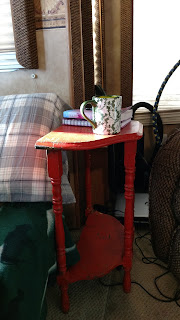Four years ago, after some unsuccessful and mostly depressing attempts at online dating, I’d sworn off men and any hope of a romantic relationship. Instead, I concentrated on becoming an adventurous, joyful woman. But then—so very unexpectedly—I fell in love with an adventure-seeking Mountain Man who lived 300 miles away. Tired of cultivating our long-distance relationship, we decided to bridge the gap between us.
At the end of last summer, I left my newspaper reporter job and my old life in the city. Now I’m settling into my new life: living large in 323 square feet in the foothills of the Elkhorn Mountains in Eastern Oregon with the Mountain Man.
At the end of last summer, I left my newspaper reporter job and my old life in the city. Now I’m settling into my new life: living large in 323 square feet in the foothills of the Elkhorn Mountains in Eastern Oregon with the Mountain Man.
Living in a small space fits who we are now. Both of us have owned houses requiring hefty mortgage payments and endless maintenance and yard work. We are both at the point in our lives that we don’t want to be tied down by possessions or lengthy to-do lists. We’ve decided to live simply while enjoying a bountiful life rich in experiences rather than material things.
We’re well on our way to succeeding. In the six months I’ve lived here, we’ve soaked in a hot springs, performed as the musical entertainment at Anthony Lakes Mountain Resort, hiked in the Elkhorn Mountains, had a picnic while perched on a log on the banks of an alpine lake and then did some fly fishing, paddled kayaks, danced to live music at Ten Depot in La Grande, dined at the Barley Browne’s in Baker City, visited the Oregon Trail Interpretive Center in Baker, and much more.
We’ve also spent a lot of time editing possessions and determining what's essential and what isn't. What do we really need for our comfort in our tiny space? As I write, my laptop rests on the tiny red table I found at an estate sale more than a decade ago.
It takes up little floor space, but is useful for holding a laptop computer, a
cup of coffee or a bowl of popcorn. In my old apartment, I had an antique desk for my laptop, but truthfully, I usually write curled up on the couch. So the little worn table with chipped red paint fits perfectly into our tiny space.
Tiny home tip: Use floor space sparingly. Use tiny furniture with multiple uses.

Here are some tiny kitchen tips we've gleaned after living tiny for six months.
Tiny home tip: Size--and numbers--matter. Four mugs. When you live tiny, you must scrutinize every item you bring into the house and justify it taking up precious space. We have space for four mugs. When I painted this lace-covered leaf mug at a fun ceramic shop in Gig Harbor recently, I had to give the boot to my cracked Star Trek Jean-Luc Picard mug. But I couldn't completely give up Jean-Luc. He's in storage.
Tiny home tip: Use smaller dessert plates rather than larger dinner plates. We use my dessert-size English Spode plates as dinner plates. They fit in the narrow cupboard better and it's harder to overeat. The larger dinner plates didn’t
fit in the cupboard, so we are storing them.
Tiny home tip: Size--and numbers--matter. Four mugs. When you live tiny, you must scrutinize every item you bring into the house and justify it taking up precious space. We have space for four mugs. When I painted this lace-covered leaf mug at a fun ceramic shop in Gig Harbor recently, I had to give the boot to my cracked Star Trek Jean-Luc Picard mug. But I couldn't completely give up Jean-Luc. He's in storage.
 |
| If you had cupboard space for only four mugs, which mugs would you choose? |
Tiny home tip: Use vertical space to double the number of spices in the spice rack. We could fit only nine spice bottles in our tiny
home’s built-in spice rack, so the Mountain Man took the built-in spice rack to
his wood shop and built a second tier, essentially doubling the number of spices
it holds without increasing its footprint on the counter. It allows us to keep
our essential, every-day spices at hand. The rest we store in a box in an overhead
cabinet in our living/dining/kitchen.
Tiny home tip: Edit your appliances to the essential. We use our hotpot daily to make coffee and tea. It's the only appliance that gets real estate on the tiny kitchen counter. I donated my bread machine and toaster and am storing our crock pot and blender. But lately, I’ve been hankering for one of my childhood comfort foods: cinnamon toast. Do I find a tiny toaster or toaster oven? If so, where would we store it when we aren't using it? Or do I forgo toast altogether?
Tiny home tip: Tuck the cutting board away when not in use. To eliminate counter top clutter, the Mountain
Man built a holder for our cutting board. When we aren’t using our 12 x 12 cutting
board, it’s neatly tucked below a kitchen cabinet.
Tiny home tip: Edit your appliances to the essential. We use our hotpot daily to make coffee and tea. It's the only appliance that gets real estate on the tiny kitchen counter. I donated my bread machine and toaster and am storing our crock pot and blender. But lately, I’ve been hankering for one of my childhood comfort foods: cinnamon toast. Do I find a tiny toaster or toaster oven? If so, where would we store it when we aren't using it? Or do I forgo toast altogether?
 |
| Essential appliances:our hot pot plus microwave, propane range and oven and refrigerator. I can live without a dishwasher, but I can't live without my morning coffee. |
Tiny home tip: Hang the broom on the wall. We have no broom closet, so the Mountain Man built a
wooden holder to hang a broom high on the wall near the ceiling. It’s out
of the way, but easy to reach.
Tiny home tip: Place the dish drainer over one side of the double sink. And wash dishes as you get them dirty. Even if you're just eating a bowl of cereal and drinking a cup of coffee, wash up after yourself. Keep your tiny counters uncluttered and ready to use. We have no dishwasher, but I don't mind hand-washing dishes.
 |
| Our tiny kitchen has a double sink. We found a stainless steel dish drainer that fits perfectly in one sink. |
Tiny home tip: Keep clutter off kitchen counters so you have space for cooking and meal prep--even if it's just making a simple peanut butter sandwich.
 |
| A bigger view of our tiny kitchen. |
 |
| Vintage and practical: our 1950s Italian Bascal aluminum cups and tiny bowls stack neatly in the cupboard and take up a tiny footprint in our tiny kitchen. I snagged them at an estate sale years ago. |
 |
| A bare bones silverware drawer: six forks, knives and spoons. |
 |
| Two narrow shelves hold most of our dishes, including our Spode plates and Fiestaware bowls. |
Tiny home tip: Where possible, incorporate whimsy--and your personality--in practical tools.
 |
| R2-D2 egg timer at the ready in an old enamel bowl above the sink. The droid egg timer was a gift from the Mountain Man, I also display a Millennium Falcon serving platter. |






